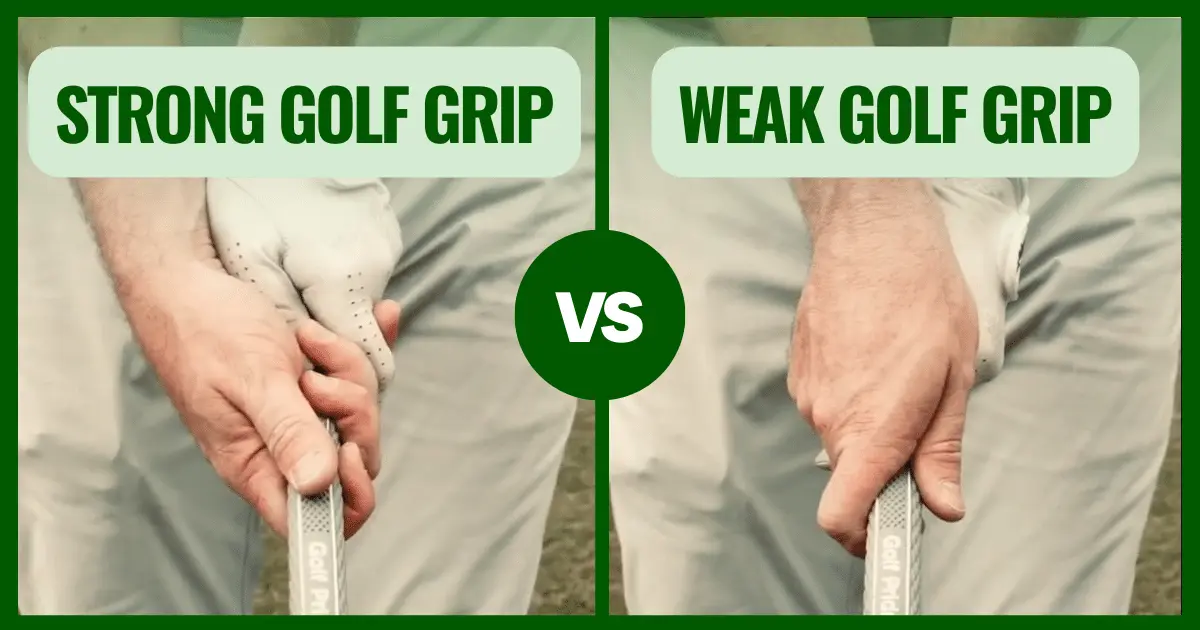In golf, the terms “strong grip” or “weak grip” refer to the positioning of the hands on the club, specifically the placement of the top hand (left hand for a right-handed golfer) relative to the clubface. The way you grip the club can have an impact on the flight and direction of your shots.
A strong golf grip involves placing the hands more to the right (for a right-handed golfer) on the club, promoting a closed clubface at impact.
On the other hand, a weak golf grip involves placing the hands more to the left (for a right-handed golfer) on the club, resulting in an open clubface at impact.
And if we mix both strong and weak golf grip we get a neutral grip. A neutral golf grip involves placing the hands in a balanced position on the club, promoting a square clubface at impact.
Let’s take a closer look at both types of grips and their effects:
Strong Grip
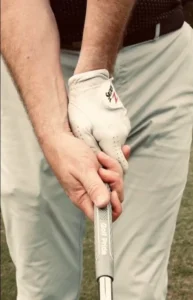
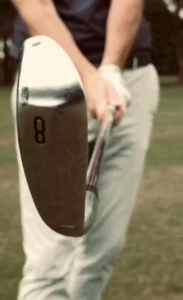
- A strong grip involves rotating both hands more to the right (for a right-handed golfer) on the club handle (left if you’re a left-handed golfer).
- The “V” formed by the thumb and index finger of each hand will point more towards the right shoulder (left shoulder for a left-handed golfer).
- A strong grip promotes a closed clubface at impact, which means the clubface is more likely to be angled towards the left of the target (right for a left-handed golfer).
- This grip can help golfers who tend to slice the ball, as it encourages a draw or reduced slice spin on the shot.
Benefits of a Strong Golf Grip:
- Reduced Slice: A strong grip can help golfers who struggle with slicing the ball. By promoting a closed clubface at impact, a strong grip can help reduce slice spin and encourage a draw or straighter shot.
- Increased Distance: When the clubface is more closed at impact due to a strong grip, it can lead to a more efficient transfer of energy from the clubhead to the ball. This transfer of energy can result in increased distance on your shots.
- Improved Control in Wind: In windy conditions, a strong grip can be beneficial. The closed clubface helps counteract the effects of crosswinds, allowing for better control over the ball’s flight.
Problems of a Strong Golf Grip:
- Potential Hook Tendency: A strong grip can sometimes lead to a tendency to hook the ball excessively. With a closed clubface, it’s important to maintain proper swing mechanics to avoid over-rotating the clubface and producing a hook.
- Reduced Shot Variety: A strong grip may limit your ability to shape certain shots. It can be more challenging to hit fades or intentional slices with a strong grip, as the closed clubface naturally promotes a draw or reduced slice spin.
- Difficulties in Clubface Alignment: Maintaining consistent clubface alignment throughout the swing can be more challenging with a strong grip. It requires careful attention and proper swing mechanics to avoid excessive closure or manipulation of the clubface during impact.
- Individual Comfort and Feel: Grip preference is subjective, and some golfers may find a strong grip uncomfortable or unnatural. It’s essential to find a grip that feels comfortable and allows you to maintain proper control and consistency throughout the swing.
Weak Grip
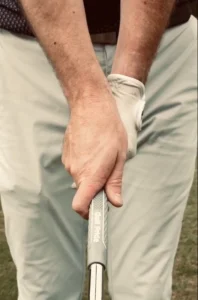

- A weak grip involves rotating both hands more to the left (for a right-handed golfer) on the club handle (right if you’re a left-handed golfer).
- The “V” formed by the thumb and index finger of each hand will point more towards the center or left shoulder (right shoulder for a left-handed golfer).
- A weak grip promotes an open clubface at impact, which means the clubface is more likely to be angled towards the right of the target (left for a left-handed golfer).
- This grip can be beneficial for golfers who tend to hook the ball excessively, as it helps to reduce the hook spin and promote a straighter or fade ball flight.
Benefits of a Weak Golf Grip:
- Reduced Hook: A weak grip can help golfers who struggle with excessive hooking of the ball. By promoting an open clubface at impact, a weak grip can reduce hook spin and encourage a straighter or fade shot.
- Shot Shaping: With a weak grip, it can be easier to shape shots intentionally. The open clubface allows for more flexibility in manipulating the face angle, making it more accessible to hit fades or intentional slices.
- Better Adaptation to Firm Course Conditions: A weak grip can be advantageous when playing on firm and fast course conditions. The fade shot created by a weak grip tends to have less spin and can prevent excessive rollout on the fairways and greens.
Problems of a Weak Golf Grip:
- Increased Slice Tendency: While a weak grip helps reduce hooks, it can potentially lead to a tendency to slice the ball. The open clubface at impact requires proper swing mechanics to avoid excessive slicing or producing a weak shot to the right (for right-handed golfers).
- Potential Distance Loss: In some cases, a weak grip may lead to a loss of distance. The open clubface at impact can decrease the efficiency of energy transfer from the clubhead to the ball, resulting in reduced distance compared to a square or closed clubface.
- Limited Draw Shot Capability: With a weak grip, it can be more challenging to hit a draw shot, which is a shot that curves from right to left (for right-handed golfers). The open clubface promotes a fade or straighter shot, making it more difficult to produce a controlled draw.
- Challenges in Consistent Clubface Alignment: Maintaining consistent clubface alignment throughout the swing can be more difficult with a weak grip. It requires careful attention and proper swing mechanics to avoid excessive opening or manipulation of the clubface during impact.
Which one should you be using?
There are 3 things you should consider before choosing one.
1. Shot shape preference
Do you generally prefer to hit draws or fades? This information can help determine whether a strong or weak grip might be more suitable for you.
For example:
- If you prefer to hit draws: A stronger grip can help promote a draw shot shape by closing the clubface at impact.
- If you prefer to hit fades: A weaker grip can assist in hitting fades by keeping the clubface more open at impact.
2. Ball flight tendencies
Do you tend to slice or hook the ball? Understanding your common ball flight tendencies can give insights into whether adjustments to your grip might be beneficial.
For example:
- If you tend to slice the ball: A stronger grip can help reduce or eliminate a slice by encouraging a closed clubface through impact.
- If you tend to hook the ball: A weaker grip can help reduce or eliminate a hook by promoting a more open clubface at impact.
3. Physical considerations
Are there any physical limitations or conditions that may influence your grip? This could include factors such as hand size, strength, flexibility, or any past injuries that affect your grip comfort and control.
For example:
- If you have smaller hands: A weaker grip might be more comfortable and allow for better control.
- If you have limited wrist flexibility: A stronger grip might help compensate for the restricted range of motion.
As a beginner which golf grip should I use? Strong or weak?
The most commonly recommended grip for beginners is the neutral grip, which is neither too strong nor too weak.
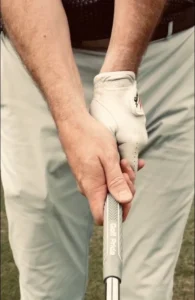

The neutral grip allows for a natural and comfortable hand position on the club, which can help you develop proper swing mechanics and increase your chances of hitting the ball consistently.
Read this article “Proper Golf Grip” if you want to know more about it.
Is a strong grip better than a weak grip?
The choice between a strong grip and a weak grip depends on factors such as swing characteristics, shot tendencies, and personal preference.
A strong grip can benefit golfers who struggle with slicing, providing a closed clubface, increased distance, and control in the wind. However, it may lead to potential hook tendencies and reduced shot variety.
A weak grip can help those with excessive hooks, allowing for shot shaping and adaptability on firm courses, but it may increase slice tendencies and limit draw shots.
Ultimately, the choice depends on individual needs and comfort, and experimentation with guidance from a professional is recommended.
Does strong grip make ball go left?
Yes, a strong grip can cause the ball to go left (for a right-handed golfer) or right (for a left-handed golfer) due to the closed clubface position it promotes at impact.
However, the actual ball flight depends on various factors like swing path, clubface control, and body alignment.
While a strong grip encourages a draw or hook, achieving the desired shot shape requires considering overall swing mechanics and other technique elements.
Final Thoughts – Strong Vs Weak Golf Grip
In conclusion, the strong golf grip vs weak golf grip debate adds a touch of excitement and personalization to the game.
It’s like choosing between two unique flavors of ice cream – both have their own delightful qualities! A strong grip can rescue those troubled by slicing, bringing a sweet draw or straight shot, while a weak grip can save those battling excessive hooks with its fade-inducing charm.
Embrace the joy of experimenting with different grips, seeking guidance from professionals, and finding the grip that feels like the perfect fit for your game.
Remember, the journey to better golf is a delicious adventure filled with delightful surprises and a scoop of personal preference!
Hi! I am Hannah, a golf enthusiast, have been perfecting my swing for over a decade, making long putts a breeze. Aside from playing, I am a professional golf writer, I try capture the nuances of the game and inspire others to embrace their love for golf. Follow me on Twitter.

